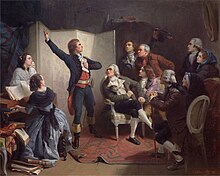Symbolism in the French Revolution
To this end, symbols were borrowed from historic cultures and redefined, while those of the old regime were either destroyed or reattributed acceptable characteristics.
The French Republic continued this Roman symbol to represent state power, justice, and unity.
[3] The blue and red cockade was presented to King Louis XVI at the Hôtel de Ville on 17 July.
[6] In revolutionary France, the cap or bonnet rouge was first seen publicly in May 1790, at a festival in Troyes adorning a statue representing the nation, and at Lyon, on a lance carried by the goddess Libertas.
The cap implies ennobling effects, as seen in its association with Homer's Ulysses and the mythical twins, Castor and Pollux.
The Roman tribune Lucius Appuleius Saturninus incited the slaves to insurrection by displaying a pileus as if it were a standard.
According to the Revolutions de Paris, it became "the symbol of the liberation from all servitudes, the sign for unification of all the enemies of despotism.
The Liberty Tree, officially adopted in 1792, is a symbol of the everlasting Republic, national freedom, and political revolution.
In time, however, the Bastille had transitioned from being a prison, to housing primarily weapons, though the symbolism remained, and the building had become synonymous with the French monarchy and tyrannical reign.
[28] The statue of Hercules, placed at the station commemorating the fall of Louis XVI, symbolized the power of the French people over their former oppressors.
First, because Hercules was a famous mythological figure, and had previously been used by the monarchy, he was easily recognized by educated French observers.
Additionally, Hercules recalled the classical age of the Greeks and the Romans, a period which the revolutionaries identified with republican and democratic ideals.
In discussions over what symbol to use for the Seal of the Republic, the image of Hercules was considered but eventually ruled out in favor of Marianne.
The anthem's evocative melody and lyrics have led to its widespread use as a song of revolution and its incorporation into many pieces of classical and popular music.
Cerulo says, "the design of "La Marseillaise" is credited to General Strasburg of France, who is said to have directed de Lisle, the composer of the anthem, to 'produce one of those hymns which conveys to the soul of the people the enthusiasm which it (the music) suggests.
"[32] Invented by a physician during the Revolution as a quicker, more efficient and more distinctive form of execution, the guillotine became a part of popular culture and historic memory.
Doyle comments: The rhetoric of violence in the French revolution was heavily influenced by the tendency to turn to the phenomena of the natural world in order to describe and explain the changes in society.
From being a source of potential destruction and catastrophe, the volcano later symbolised a ‘constructive revolutionary transformation’ during the Reign of Terror.
As the political situation again shifted, the image of the volcano eventually returned to its status as a force of unrelenting power.
The changing symbolic meanings of the volcano in themselves present the Revolution as a source of unpredictable and inevitable destruction that lay beyond human control.
[38] However, given the animosity of the French people, their rising political dissatisfaction and restlessness, even the metaphor of a scorching volcano paled.
Even metaphors drawn from the furious glory of nature failed to describe the ferocity of a nation and its people scorned.
This metaphorical transformation is reflected in genres across the literary spectrum, including the birth and increasing popularity of the novel as a form of expression.
Writing twenty years before the 1787 Assembly of Notables, the political philosopher Jean Jacques Rousseau emphasised seismic activity, such as volcanic tremors, blasts and pyroclastic surges, as a key force behind the spread of early human civilisation.
[40] Rousseau’s optimistic vision of naturalised change, of upheaval as a generative and progressive stage in the life cycle of governance, is echoed, but not shared by the British radical press.
When the image of the volcano became codified as the stamp of French, revolutionary threat is unclear, however, multiple citations can be traced through broadsheets issued between 1788 – 1830.
In his Weekly Political Register, the parliamentarian William Cobbett warns against ‘the burning lava of the French Revolution’ and deplores the day when ‘our (British) power (will be) crippled by such convulsion of nature’.









